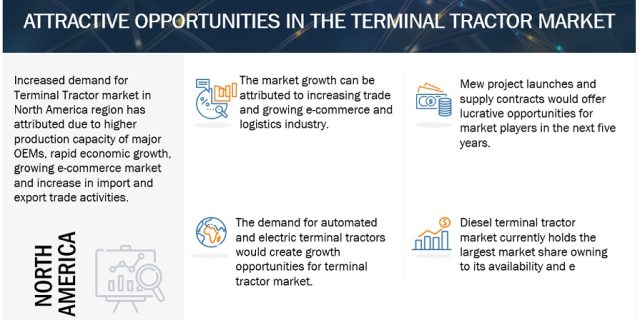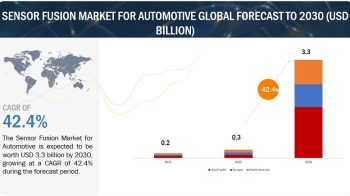
The terminal tractor market is projected to grow from USD 1.4 billion in 2024 to USD 1.9 billion by 2030, at a CAGR of 5.5%. Terminal tractors also referred to as shunt trucks, yard trucks, or spotting trucks, are primarily utilized for handling forty or twenty-foot equivalent units (TEUs) within port warehouses and terminals. In recent years, there has been a notable rise in sales growth for these vehicles, predominantly diesel-powered. The electric terminal tractor market is estimated to be the fastest growing in the forecast period as there’s been a noticeable rise in the adoption of electric terminal tractors due to the increasingly stringent emission norms, sustainability goals of terminals and ports, and declining battery prices. North America remains the largest market for terminal tractors, followed by Europe and the Asia Pacific region.
Market Dynamics
DRIVER: Growing demand from e-commerce and logistics industries
As the global e-commerce market continues to expand rapidly, logistics companies are experiencing heightened demand for their services. This surge has led to changes in warehousing, transportation, and delivery processes, along with challenges like supply chain disruptions and the need for sustainability. This would drive the demand for efficient and sustainable terminal tractors to operate on terminals and ports for transportation purposes. The International Trade Administration forecasts global e-commerce revenue to reach USD 5.5 trillion by 2027, with consumer electronics, fashion, furniture, and bio-health pharmaceuticals leading the market. In the US, the Census Bureau reported that adjusted retail e-commerce sales hit USD 285.2 billion in the fourth quarter of 2023, a 0.8% rise from the previous quarter. Leading e-commerce companies are focusing on stocking a large volume of products in their warehouses, improving order accuracy, offering same-day or same-hour delivery, and providing free returns to stay competitive. They are also seeking cost-effective ways to reduce delivery times and handle large quantities. The rise in e-commerce sales necessitates more terminal tractors for loading and unloading goods, reducing turnaround time at distribution centers. This is expected to drive the demand for terminal tractors in cargo handling during the forecast period.
Download PDF Brochure @ https://www.marketsandmarkets.com/pdfdownloadNew.asp?id=153834794
OPPORTUNITY: Strong inclination towards electric terminal tractors
The growing preference for electric terminal tractors offers significant opportunities for the market. Stringent environmental regulations and a focus on sustainability are pushing companies toward cleaner transportation solutions. Electric terminal tractors, with zero tailpipe emissions, meet these regulatory demands and enhance sustainability. Despite higher initial costs, electric models provide long-term savings through lower fuel and maintenance expenses, supported by declining battery prices and fewer moving parts. Government incentives further reduce upfront costs, accelerating adoption. Advances in battery technology, improving range and charging times, make electric tractors more efficient and reliable for various applications. Additionally, features like automation and quieter operation enhance operational efficiency, creating a safer and more productive work environment.
The Warehouse & Logistics segment is estimated to be the largest segment during the forecast period.
Warehouse and logistics applications will lead the terminal tractors market during the forecast period of 2024-2030. The rise of e-commerce, logistics, and retail activities and the consequent need for efficient supply chain management have significantly increased the demand for terminal tractors to handle the high volume of goods in warehouses and distribution centers. According to the Forbes Advisor, the global e-commerce market will reach USD 56.4 trillion by the end of 2024, and China and the US being the top two countries at a global level. Additionally, the global warehousing and logistics market is estimated to grow with the Asia Pacific region leading due to expanding trade routes and industrial shifts. The increased market demand has emerged the need for rapid turnaround times in warehouses and integration of smart technologies with a push towards automation and efficiency in logistics operations for better fleet management and operational efficiency. This will prompt the growth of advanced terminal tractors for this application to meet the customer expectations for fast delivery of goods and parcels.
Electric propulsion type is projected to be the fastest growing market for terminal tractors from 2024 to 2030.
Electric terminal tractors are estimated to grow at the fastest CAGR during the forecast period. The shift is mainly driven by global environmental concerns and stringent emission laws for on-road as well as off-road vehicles which have noticed a constant upgradation across different regions in recent years. Battery electric terminal tractors significantly reduce fuel expenses and eliminate the need for several maintenance services, such as oil changes, transmission, fan belts, air filters, and other traditional fuel-based engine services. According to a report published by the North American Council For Freight Efficiency (NACFE), the maintenance expenses for a battery electric terminal tractor are significantly lower compared to the latest diesel-powered terminal tractors (manufactured in 2017 or later, equipped with DPF and SCR systems), with a reduction ranging from 60% to 75%. Though the initial cost of electric terminal tractors is higher than diesel tractors, however, as battery technology advances with reduced lithium prices, and lowered cost of related components, the overall total cost of ownership (TCO) is expected to go down drastically for electric propulsion. Further, with improving charging infrastructures at port terminals, warehouses & distribution centers, and rising regulatory support in terms of tax benefits or incentives, the market for electric terminal tractors is expected to notice an improved acceptance rate in the coming future.
North America is estimated to be the largest market for diesel terminal tractors.
North America is estimated to dominate the terminal tractors market in which the US leads the regional demand which is mainly driven by its large industrial base, including automotive manufacturing, aerospace, and defense. The maximum share of this regional segment can be attributed to the region’s extensive port infrastructure, high demand for efficient logistics operations, and strong regulatory support for emission reduction. The presence of major ports along the East and West Coasts, as well as the Gulf of Mexico, drives substantial demand for advanced terminal tractors to handle the high volumes of cargo. Further, the growth of the e-commerce sector has led to increased demand for warehouses. According to the US Department of Commerce, US e-commerce stands in the 2nd position of the top 10 e-commerce countries. In 2023, the total US e-commerce sales reached USD 1,100 billion from USD 787.8 billion in 2020. Further, the Census Bureau of the Department of Commerce estimated that the US retail e-commerce sales for the first quarter of 2024 stood at USD 289.2 billion. The increased demand for material handling equipment is expected to drive the terminal tractor market during the forecast period. Additionally, port operators are also keen to deploy advanced technologies. Regional players are constantly making innovations in the field of high capacity, fast-charging battery systems, and autonomous driving technologies. Companies like Kalmar, Terberg, and BYD are focusing on enhancing the performance, reliability, and sustainability of terminal tractors. For instance, Kalmar’s electric terminal tractors leverage NMC battery technology for extended range and better efficiency, while Terberg’s YT203-EV incorporates advanced thermal management systems for optimal performance in varied climates. All these factors are expected to boost the demand for terminal tractors in the North American region.
Key Market Players:
The report profiles key players such Kalmar (Finland), Terberg Special Vehicles (Netherlands), Capacity Trucks (US), MAFI Transport-Systeme GmbH (Germany), and TICO Tractors (US). These companies adopted new product development, and supply contract strategies to gain traction in the terminal tractor market.
Request Free Sample Report @ https://www.marketsandmarkets.com/requestsampleNew.asp?id=153834794


